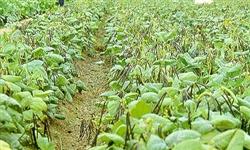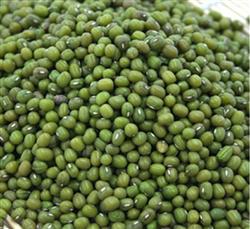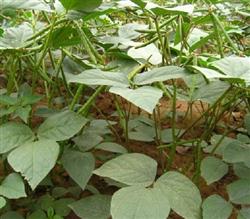Cultivation techniques of mung bean

(1) although mung bean rhizobium has the ability of nitrogen fixation, the application of farm manure and phosphorus and potassium fertilizer can obviously increase the yield. The application of farm manure can be given to people once before sowing, and ploughed and turned over after application. If it is too late to apply basal fertilizer, it is necessary to apply a certain amount of nitrogen and phosphorus fertilizer in the early growth stage, that is, the branching and early flowering stage, in order to enhance the nitrogen fixation ability of rhizobium and increase flower bud differentiation. (2) sowing mung beans can be sowed in spring and summer. Spring sowing is from late April to early and mid-May. Summer sowing is in mid-and late June, so we should strive to sow early. Mung bean seeds have 10% small hard particles, which are difficult to germinate after sowing, which can easily cause lack of seedlings and broken ridges, so they should be screened out before sowing. The sowing rate per mu is generally 1.5 Mel 2 kg, and the sowing depth is 3 mi 5 cm. (3) Field management 1. Interseedling and fixed seedling when mung bean reaches two leaves and one heart after emergence, pimple seedlings should be removed. When 4 leaves, the plant spacing is 13-16 cm, the row spacing is about 40 cm, and 1-12500 seedlings per mu is suitable. 2. From seedling emergence to flowering and ridge sealing, mung beans are generally hoed at least four times, and the depth of intermediate ploughing is from shallow to deep and then to shallow. 3. The flowering and podding period of mung bean in irrigation and drainage is the peak period of fertilizer and water. if there is drought in this period, it should be watered in time to keep the soil moist. However, the flowering and podding period is often in the rainy season, which makes the stems and leaves grow, resulting in a large number of falling flowers, pods, or stagnant water and death. It is necessary to drain water in time to ensure the normal growth of mung beans. 4. Intercropping mung bean has strong shade tolerance, interplanting or mixed with tall stalk crops in production. This paper introduces several forms: interplanting mung bean spring corn in large and small rows, big row 1 meter, small row 50 cm, plant spacing 33 cm, about 2650 plants per mu; or large row 1.6m, small row 50 cm, plant spacing 26 cm, about 3000 plants per mu. After pollination, precocious mung beans with short growth period, small plants and concentrated pods were interplanted with 3Mel among large rows. The row ratio is 2:4, or the row ratio is 1:1, that is, single-row spring corn with single-row mung beans, this type of mung beans is too shady, affecting the yield. Summer corn was planted with mung beans in large and small ridges, and two rows of precocious mung beans were interplanted between rows. If interplanting corn in wheat field requires mung bean, mung bean can be sown immediately after wheat harvest; if corn is replanted after wheat harvest, mung bean and corn can be sown at the same time at 2:2. After the mixed cultivation of mung bean and summer sesame, mung bean and sesame were mixed at the same time. After harvest, the mung bean was in full bloom and pod stage, and the light was sufficient, which was beneficial to the growth and fullness of mung bean. Mung bean and millet intercropping mung bean and summer millet intercropping, sowing millet and interplanting millet at 4:2 or 2:2 after wheat harvest. In short, when interplanting mung bean with corn, millet or sweet potato, the row spacing is generally adjusted to interplant mung bean without affecting the density of the main crop. If green manure is pressed with mung bean, the effect is the best at full flowering stage. If mung beans are interplanted in wheat ridges, mung beans will become monoculture after wheat harvest. (4) the prevention and control of diseases and insect pests mainly control the mung bean weevil. The adults lay eggs on the bean grains or young pods, and the larvae hatch and eat the human bean grains. Prevention and control methods: before storage, bean grains are fumigated with 1.5kg sodium cyanide per thousand cubic meters for 48 hours, the temperature is above 20 ℃, the insecticidal efficiency is 100%, and does not affect the germination rate; closed storage anoxic storage; a small amount of storage can be soaked in boiling water for 20 minutes, fished out and dried in the tank, can be preserved for a long time, and does not affect the germination rate.
- Prev

Mung bean has a good way to control insect pests in winter.
Mung bean, also known as green adzuki bean, gets its name because of its green color. It has been cultivated in China for more than 2000 years. Because of its rich nutrition and many uses, Li Shizhen called it "the best dish". But although it is nutritious and popular, the storage of mung beans is a headache. Because it was supposed to be intact.
- Next

High-yield cultivation techniques of mung bean
Mung bean is a high-protein, low-fat, medium starch, medicine and food homologous crop, is an ideal health food for people, and has high economic utilization value. The most remarkable characteristics of mung bean planting are long sowing period, short growth period, drought and barren tolerance, strong adaptability, wide cultivation range, nitrogen fixation ability, good stubble, but avoid continuous cropping.
Related
- The first cup of black tea in spring, the flavor and history of tea gardens in Kenya, Africa
- The computer can not only choose potatoes, but also grow tea rice. AI will grow winter oolong tea champion.
- It is not only the inflated tea bitten by insects, but also engraved with the four seasons tea in Beipu.
- The Oriental Beauty Tea Festival in Zhuxian County takes the stage at the weekend to experience the plus-size feast of oil tea.
- & quot; Oriental Beauty Tea & Exploration of Emei in Hsinchu, the hometown of quot;
- The new variety of strawberry "Tainong 1" dessert is the first choice with mellow aroma. Crimson gorgeous
- History of Tea in Taiwan: from Wild Inner Mountain to Export Tea Garden
- Two types of Taiwan Oriental Beauty Black Tea won the British three-Star Award for Childhood Tea Xiang Zhang Jiaqi changed from pilot to champion tea maker.
- Banana species and varieties: the planting history of Taiwan Xianren banana and dwarf banana is long, is banana disease resistant?
- Coffee planting Technology: Qianjie Coffee from Seedling to harvesting

